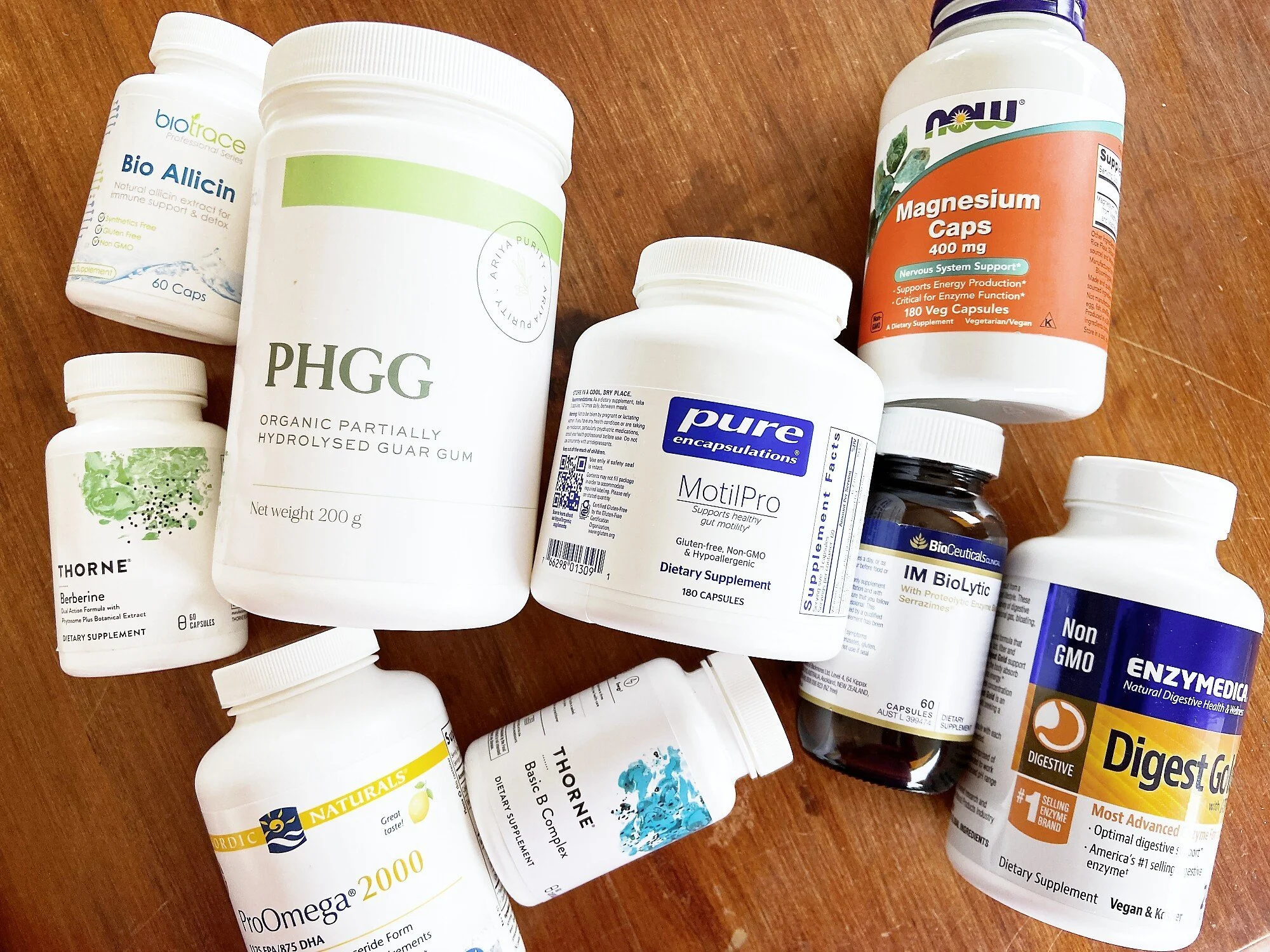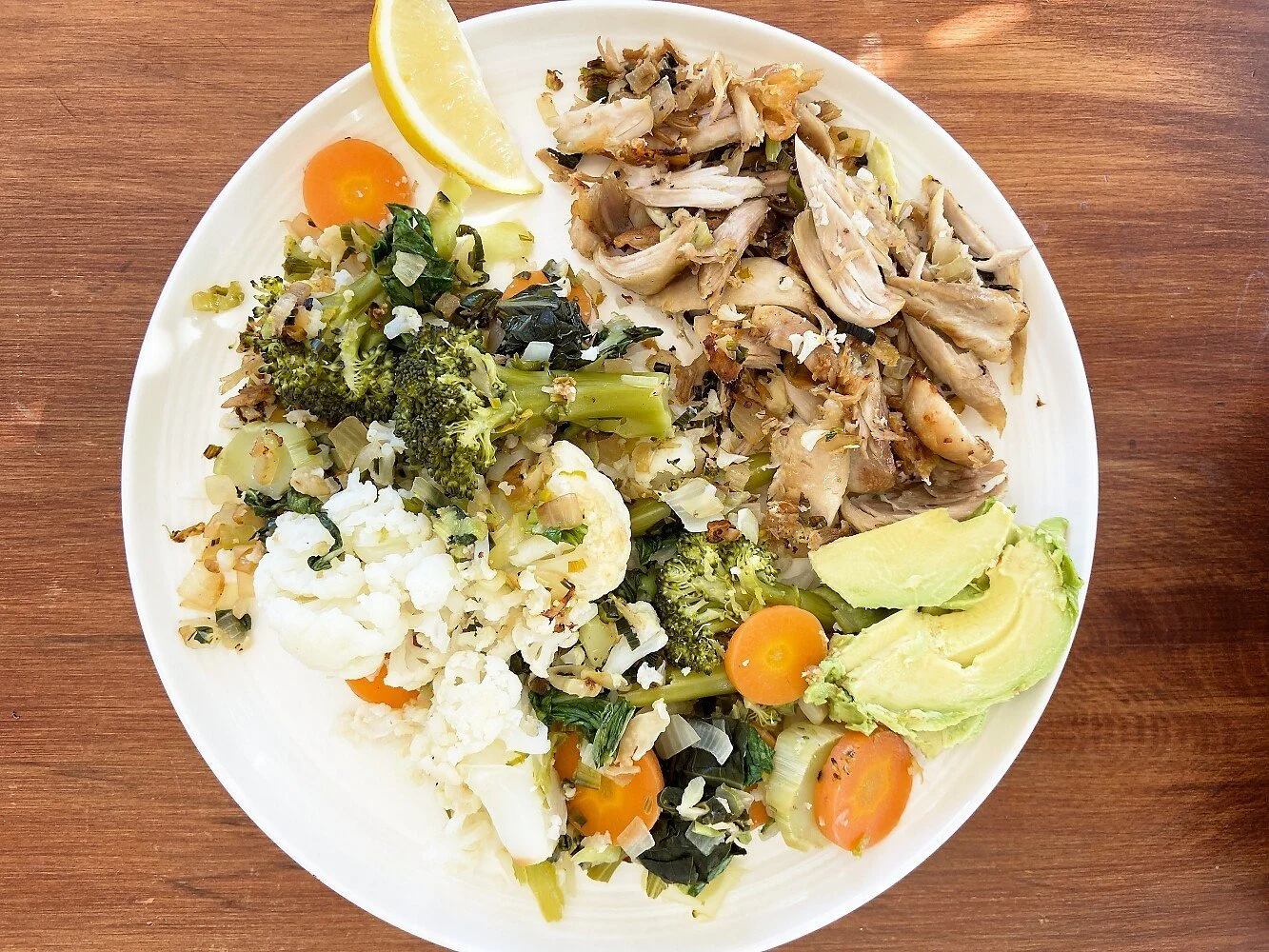My Exact Supplement Strategy That Got Rid of SIBO-C / IMO in Two Months
Some of the links below are affiliate links (but not all of them). I hope this post is helpful, and if you decide to try some of the products, I appreciate your support (at no extra cost to you of course).
I’ve talked about my journey with mold toxicity and gut issues before. Today I’m hoping it will be valuable to dive into my exact supplement protocol that helped me completely eliminate SIBO-C (or now called IMO, which stands for Intestinal Methanogen Overgrowth) within two months.
First, however, I have to mention that I work with a practitioner and have her support. So, if you’re struggling with SIBO by yourself, I always recommend reaching out to someone qualified who might be able to help.
I’m not a doctor, I just have done a lot of research and am hopeful that sharing my experience can help you. But you should always consult with your practitioner or doctor before implementing new protocols, and of course use your own best judgement.
Second, while supplements were a huge part of my SIBO-elimination strategy, diet, sleep, exercise, stress management and lifestyle strategies were equally as important. I’ll talk about these below in more detail.
A little bit of background. My first SIBO test came back positive for methane-dominant SIBO. While the levels weren’t crazy elevated, it was still positive. So after protocols for treating H-Pylori, Candida, and Mold, we moved on to clearing my SIBO/IMO. Then, after retesting about two months later, the SIBO test was negative. So what helped to get rid of SIBO so fast?
SIBO / IMO Eradication Supplement Protocol
There are a few parts to this supplement protocol.
If you purchase any of the supplements through the links below, use code NEW20 for 20% off if you’re a new customer, or GOLD60 for 10% off $60USD on iHerb).
1. Supporting Bowel Movements with Magnesium
This one is still (and has been for a long time) an ongoing supplement in my routine. It’s important to keep your colon clear and have regular, daily bowel movements. I’ve found this magnesium to work best (it’s cheap - and that’s what you want. You want it to not be well absorbed, but to draw water into your colon).
I take 2-3 capsules each night with a tall (!!) glass of warm water (mixing cold water with a little bit of boiling water). There have been nights where I even had to go up to 4 capsules, when constipation got really bad.
Because I don’t want to get up at night having to pee, I usually take it an hour or so before dinner, in the early evening. If this isn’t an issue for you, then you can also take it before bed.
If you’re using magnesium and not seeing any relief, make sure that it’s the right form, that you’re taking enough, and that you’re drinking enough water with it.
2. Supporting Digestion and Detoxification
I’ve been taking digestive enzymes for a while now. It’s also an ongoing part of my supplement regimen. I find these to work really well (some of the best quality ones out there), and they definitely help with digesting food and breaking down carbs, protein and fat. I take one capsule with every main meal, just before I start eating (so three times a day).
There are other digestive enzymes you could try of course, but I’ve found this to be the one that worked best for me (I tried a few).
To support detoxification, I was taking Calcium D-Glucarate to prevent hormones and environmental toxins from recycling in my system and to support liver detoxification.
3. Anti-Inflammatory
I take this omega-3 supplement for dealing with inflammation and supporting my overall health. It came highly recommended by my functional gut nutritionist (she has worked directly with the company in the past and mentioned the high quality of it).
There are sooo many omega-3 supplements on the market, it can be hard to know which one to take. Whatever you decide, just make sure you’ve researched well and looked into the company. You definitely don’t want to take a rancid or oxidized omega-3 product, which would do more harm than good. This is one of those times where you want to spend a little more to make sure you’re getting a clean, quality product.
I take 1 or 2 capsules daily (depending on how I “feel” my inflammation levels are). Because this one is a high-strength one, you can take just one a day, whereas some of the other omega-3 supplements (even from the same brand) are a weaker dosage, so you end up taking more capsules to get the same amount of omega-3.
NOTE: You could also get this one, which is the exact same one (one of them is marketed at practitioners while the other one is aimed at direct consumers) - so the only difference is the design and name. Sometimes it’s helpful to know, in case one of them is sold out.
4. Supporting Energy and Nervous System Support
I take this Vitamin B Complex for neurotransmitter synthesis, supporting energy production, mood, and supporting the nervous system (among others). Thorne is a reputable company, and I find this product is reasonably priced as well.
I take one capsule in the mornings with breakfast.
5. NAC (or Liposomal Glutathione)
NAC is a precursor of L-Cysteine, which is needed for creating glutathione - a cellular antioxidant important for regulating oxidative stress, detoxification and immune function. You could also take liposomal glutathione (one less conversion step). I started with liposomal glutathione, then switched to NAC after a few months.
I was taking 1g NAC each night before bed (that’s two capsules).
6. Supporting Gut Diversity
This early on in my gut-healing journey (and after some rounds of previous antimicrobials), the only prebiotic that we added in is PHGG (also called sunfiber). I tolerated it well, and I am certain that it helped with gut motility and bowel movements.
Be sure to titrate it in slowly! Start with a little sprinkle and slowly work your way up to 6g a day. I take mine with dinner each night and some water.
7. General Health and Immune Function
I don’t have a regular routine with Vitamin D, but I take a few drops every few days. Sometimes I forget for a few days, then I take 10-15 drops or so at once. Other times I just take 4-6 drops (1000-3000 IU Vitamin D) each day. The amount you take really depends on your current Vitamin D levels - so be sure to get them checked out.
This Vitamin D + K2 is my favorite. It contains the right ratio of Vit D to K2, and also uses the MK4 form of Vitamin K2 (which, from my hours of research, seems to be the better option long-term).
Don’t forget to use code NEW20 for 20% off if you’re a new customer, or GOLD60 for 10% off $60USD on iHerb.
8. SIBO Eradication
Now for the part you’ve been waiting for. However, don’t forget that all the previous supplements are the basis of this elimination protocol! I don’t know if I would have been able to clear SIBO without the above supporting supplements and strategies! Probably not.
I went through 2 months of SIBO eradication.
For the first month, I was taking BioAllicin (or you could take AlliUltra) and Oil of Oregano. For month two (once I had finished all bottles of BioAllicin and Oregano Oil), I switched to Berberine and Neem.
Throughout this time, I used a strong and high quality biofilm disruptor to break down the biofilm, as well as activated charcoal (pretty much any brand of activated coconut charcoal will do) to bind to toxins and waste products. (And then it’s important to get them out of your system every day - one reason to not dismiss all the other supplements I talked above, which help with that).
At first I saw good results during month two with the Berberine and Neem combination, but then Berberine became too much and I had to take a short break (twice). (This is a “when you know, you know” situation). Berberine made me feel super nauseous and like I didn’t want to eat at all - or if I thought about food, all I wanted was white bread, crackers, and maybe a banana. Not ideal.
Two things you can do: 1. Start slowly - titrate in each supplement - slowly! 2. If you get to a point where you’re really struggling, take a break from Berberine for a few days until you’re feeling better. Then titrate it back in slowly.
I believe that maybe there’s a “threshold” in the body for Berberine, and once that bucket is full, you just need to stop taking it and wait for the overall levels to drop down again.
I was worried that this stop-and-go situation would mess up my SIBO eradication - but it was completely fine! I’m so grateful for this.
Whatever issues you’re struggling with during your die-off phase or because of Berberine, know that it’s only temporary!!! It’s worth getting through this!
I also believe that slowly getting used to a supplement is key. I stopped Berberine twice. The third time I went back to the full dose, I had no issues at all. It’s like my body just needed more time getting used to it.
Don’t forget to use code NEW20 for 20% off if you’re a new customer, or GOLD60 for 10% off $60USD on iHerb.
9. SIBO Eradication and Relapse Prevention:
It’s key that you don’t just clear your SIBO and then stop. It’s really common for SIBO to come back, and one way to help prevent a relapse is by taking a good prokinetic (or you could take this one - 3 caps twice daily, before bed and upon waking) to support gut motility.
I was and am still taking a prokinetic (and likely will continue this for up to 6 months post-SIBO eradication).
Diet, Lifestyle Strategies and Stress Management
I mentioned earlier that it’s not just about supplements, but that everything else is just as important when it comes to getting rid of SIBO/IMO.
1. Focus on switching from the sympathetic to the parasympathetic nervous system, and manage stress levels
One way you can calm down is by doing some deep breathing. I like to do this for a couple of minutes before meals.
Other ways to relieve stress include meditation, yoga, going for a walk, exercise (but not too much or intensely to a point where it becomes too stressful for the body and it starts affecting your hormones), and a few other unique stress management techniques I’ve written about here.
2. Eat your meals in peace and in a relaxed state
Deep breathing right before a meal can help with this.
3. Paleo-style, low sugar diet
I followed a Paleo-style diet that’s low in sugar (i.e. no maple syrup, honey, or high-sugar fruit) - note: not a low carb diet. It’s worth noting though, that I wasn’t perfect! Far from it. After almost a year of being on a restrictive diet, elimination and gut healing protocols, I felt over it. I wanted freedom. So while I tried my best to follow a Paleo-style diet the majority of the time, I still had a few sugary treats every now and then, ate some chips, pizza or bread from time to time, and went out to enjoy a meal.
I was actually worried that not being very coherent to the diet would have had a negative impact on clearing my SIBO. But luckily it didn’t. (I guess my diet wasn’t as bad as it seemed to me in my “perfectionist head”). Still, I recommend you try to stick to a SIBO-eradication-supportive diet as best as you can.
4. No snacking between meals
This is important to give your migrating motor complex a chance to do its job and clear away food before your next meal. In terms of preventing a SIBO relapse, it’s key to allow at least 3-4 hours between meals - and that means no snacking.
5. Sleep
I also tried my best to get at least 8 hours of good sleep each night (ideally be asleep by 10pm, although that hardly ever happens).
Let me know if you have any questions about how I managed to get rid of IMO / Methane-Dominant SIBO - SIBO-C, or anything else I shared. I hope this post has been helpful and that you can benefit from it in some way, making your SIBO journey easier and more hopeful.













